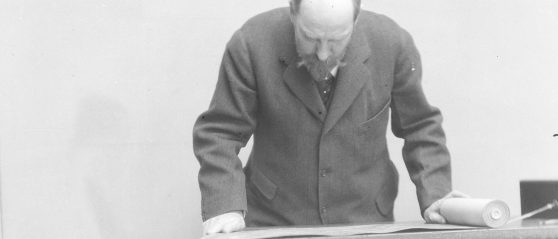October 14, 2017–September 6, 2022
-
Dates
-
Location
Gallery 9
-
Collection Area
American Art, Chinese Art, Japanese Art
Charles Lang Freer
Who has “the power to see beauty”? How much do you need to know to appreciate a work of art from another culture or historical era? Our museum founder Charles Lang Freer (1854–1919) asked himself these fundamental questions as he prepared to transfer his personal collection of Asian antiquities and American tonalist paintings to a new public museum on the National Mall.
Even though Freer left school after the eighth grade, he became a wealthy industrialist and world traveler. He had easy access to scholars, critics, and sophisticated advisors and appreciated “expert opinions.” Though he was never concerned with specific social, economic, and political circumstances affecting artistic production, he was keenly interested in how chronology, authenticity, quality, and cross-cultural interchange affected stylistic developments over the centuries.
Yet, Freer never renounced his conviction that a direct, emotional response was the highest form of aesthetic pleasure—and the most democratic, available to anyone willing to take the time to look closely. He believed quiet contemplation and intelligent (though often ahistorical and unexpected) comparisons of works of art would “induce concentration” and give all visitors “the power to see beauty.”
- Jump To...
Explore All Pieces in this Section
Vase
-
Period
Momoyama period
-
Geography
Iga kilns, Mie prefecture, Japan
-
Material
White stoneware with multiple layers of ash glaze, iron glaze; gold lacquer repairs
-
Accession
F1898.451
Black Raku ware tea bowl named Minogame (Mossy-tailed tortoise)
-
Period
Edo period
-
Geography
Kyoto, Kyoto prefecture, Japan
-
Material
Earthenware with black raku glaze
-
Accession
F1899.34a-c
Black Raku ware tea bowl
-
Period
Momoyama period
-
Geography
Kyoto, Kyoto prefecture, Japan
-
Material
Pottery with Black Raku glaze; black lacquer repairs
-
Accession
F1902.52
Resting
-
Geography
United States
-
Material
Chalk and pastel on brown paper
-
Accession
F1902.176a-d
Venus Rising from the Sea
-
Geography
United States
-
Material
Oil on canvas
-
Accession
F1903.174a-b
Variations in Blue and Green
-
Geography
United States
-
Material
Oil on millboard mounted on wood panel
-
Accession
F1903.178a-b
Portrait of Charles Lang Freer
-
Geography
United States
-
Material
Oil on wood panel
-
Accession
F1903.301a-b
Box with fitted cover
-
Period
Edo period
-
Geography
Japan
-
Material
Lacquer on wood with lead and mother of pearl
-
Accession
F1904.36a-b
Box for writing utensils
-
Period
Edo period
-
Geography
Japan
-
Material
Wood, lacquer, gold, metal, shell
-
Accession
F1904.37a-c
Box with lid
-
Period
Edo period
-
Geography
Japan
-
Material
Lacquered wood with inlaid mother of pearl and gold paint
-
Accession
F1904.347a-d
Jar
-
Geography
Syria
-
Material
Stone-paste painted under glaze
-
Accession
F1905.61
Vase, with lacquer lid for use as tea ceremony water jar
-
Period
Momoyama period
-
Geography
Imari, Saga prefecture, Japan
-
Material
Stoneware with iron and rice-straw-ash glazes
-
Accession
F1905.274a-b
Tomb jar
-
Period
Eastern Han dynasty
-
Geography
China
-
Material
Earthenware with copper-green lead-silicate glaze
-
Accession
F1906.35
Jar, large globular, with a tapering base, and cylindrical neck
-
Geography
Raqqa, Syria
-
Material
Glazed clay
-
Accession
F1906.229
Figurine of the goddess Neith
-
Period
Saite Dynasty 26 or later
-
Geography
Egypt
-
Material
Sculpture; bronze
-
Accession
F1907.1
Head and Bust (fragment) of a man
-
Period
Middle Kingdom
-
Geography
Egypt
-
Material
Limestone
-
Accession
F1907.3
Ritual vessel (lei) with dragons
-
Period
Eastern Zhou dynasty, Spring and Autumn period
-
Geography
China
-
Material
Bronze
-
Accession
F1907.33
Writing box containing ink-stone and water holder
-
Period
Edo period or Meiji era
-
Geography
Japan
-
Material
Lacquer, gold, lead, and mother of pearl
-
Accession
F1907.105a-e
Figure of Avalokiteshvara (Japanese: Kwannon), after statue in Horyuji Temple. Reduced copy
-
Period
Meiji era
-
Geography
Japan
-
Material
Wood, pigment
-
Accession
F1907.113a-e
Jar with inlaid design of three phoenixes
-
Period
Goryeo period
-
Geography
Gangjin or Buan kilns, Jeolla-do province, Korea
-
Material
Stoneware with white and black inlays and black painting under celadon glaze
-
Accession
F1907.367
Stele with Buddhist triad
-
Period
Sui dynasty or later
-
Geography
China
-
Material
Sandstone
-
Accession
F1907.506
Bodhisattva Avalokiteshvara (Kannon)
-
Period
Nara period
-
Geography
Japan
-
Material
Bronze
-
Accession
F1908.9a-d
Figure of Anubis
-
Period
Saite Dynasty 26 or later
-
Geography
Egypt
-
Material
Bronze
-
Accession
F1908.52
Bowl
-
Period
Il-Khanid dynasty
-
Geography
Iran
-
Material
Stone-paste decorated with lustre
-
Accession
F1908.163
Bottle
-
Period
Goryeo period
-
Geography
Gangjin or Buan kilns, Jeolla-do province, Korea
-
Material
Stoneware with white and black inlays under celadon glaze
-
Accession
F1909.26
Bottle
-
Period
Goryeo period
-
Geography
Haenam kilns, Jeollanam-do province, Korea
-
Material
Stoneware with black and white slips under celadon glaze
-
Accession
F1909.31
Wine ewer in the form of a melon
-
Period
Goryeo period
-
Geography
Gangjin kilns, Jeollanam-do province, Korea
-
Material
Stoneware with black inlay under celadon glaze
-
Accession
F1909.34a-b



